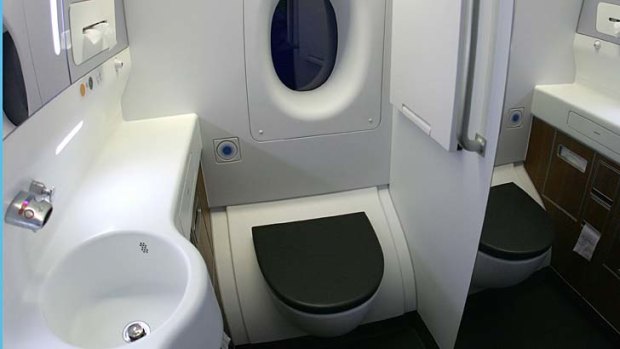By Oliver Smith

No longer a mystery ... what happens when you flush a plane toilet?Credit: Getty Images
Unless you've flown first class, or in a private jet, aircraft loos are windowless, cramped affairs that usually reek of cheap sanitizer. But they have come a long way.
An excellent article on the website Aviation Global News charts the history of the plane lavatory, and asks why the smallest room in the sky – "an unheralded hero of aircraft safety," no less – rarely gets the coverage it deserves.
The first flight (made by Orville Wright, although some conspiracy theorists think otherwise – more on that here), it explains, lasted just 12 seconds – "hardly long enough to get worked up from a bladder perspective, although one may surmise that a number two might have been on his mind".
But before long, planes were flying for much longer. "It is obvious that someone, somewhere, was the first person to relieve themselves in an aircraft. Who was this urinary pioneer? — history does not record," laments the blog. "It is a reasonable presumption that bottles, tubes and buckets were involved, but that information, too, is lost to time. Why are there so few facts recorded about early aircraft toilets? Most likely it was the squeamishness of the age."
Some interesting facts have been recorded, however. Second World War pilots, for example, couldn't stand the "slop bucket" loos – or "Elsans" – found on board Lancaster bombers. They often overflowed in turbulent conditions, or were tricky to use.
One unidentified airman described his hatred for the contraptions thusly: "While we were flying in rough air, this devil's convenience often shared its contents with the floor of the aircraft, the walls, the ceiling, and sometimes a bit remained in the container itself.
"It doesn't take much imagination to picture what it was like trying to combat fear and airsickness while struggling to remove enough gear in cramped quarters and at the same time trying to use the bloody Elsan... This loathsome creation invariably overflowed on long trips and in turbulence was always prone to bathe the nether regions of the user. It was one of the true reminders to me that war is hell." Tell us what you really think.
Crews sometimes preferred to urinate or defecate into containers, before simply hurling their business out of a window. Some reputedly jettisoned full Elsan toilets on German targets along with their bombs – an early example of biological warfare.
James Kemper's modern vacuum toilet wasn't patented until the Seventies, with the first one installed by Boeing in 1982. Before that, plane loos were unwieldy boxes that utilised large quantities of blue liquid [actually known as "Skykem", a reader has reliably informed us] and were prone to leaking. So next time you're queuing to use the facilities at 30,000 feet, count yourself lucky.
Kemper's nifty device uses a little liquid, but relies on non-stick coating and vacuum suction to wash away the nastiness.
So what does happen to all that waste? Is it jettisoned into the sky? To all those fliers who make a point of holding it in until the plane reaches French soil, prepare to be sorely disappointed.
"There is no way to jettison the contents of the lavatories during flight," explains Patrick Smith, a pilot and author of Cockpit Confidential, a book about air travel. "At the end of a flight, the blue fluid, along with your contributions to it, are vacuumed into a tank on the back of a truck. (The truck driver's job is even lousier than the co-pilot's, but it pays better.)
"The driver then wheels around to the back of the airport and furtively offloads the waste in a ditch behind a parking lot... In truth I don't know what he does with it. Time to start a new urban legend."
There is one caveat, however. It is impossible to empty passengers' waste from an aircraft intentionally, but not by mistake.
"A man in California once won a lawsuit after pieces of "blue ice" fell from a plane and came crashing through the skylight of his sailboat," added Captain Smith. "A leak, extending from a toilet's exterior nozzle fitting, caused runoff to freeze, build, and then drop like a neon ice bomb. If you think that's bad, a 727 once suffered an engine separation after ingesting a frozen chunk of its own leaked toilet waste, inspiring the line "when the s*** hits the turbofan.""
The Telegraph, London
Sign up for the Traveller Deals newsletter
Get exclusive travel deals delivered straight to your inbox. Sign up now.